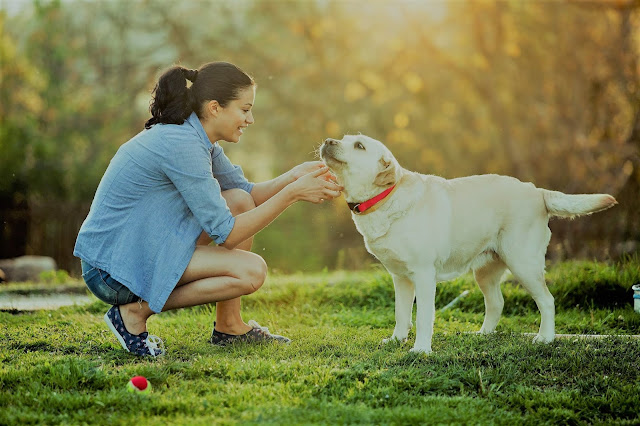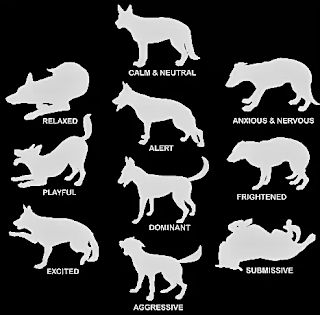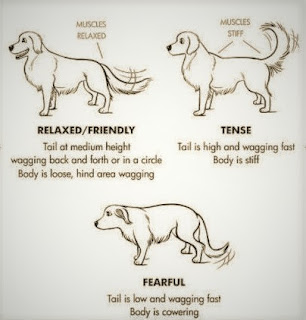Dog Body Language & How They Communicate
Different Ways Dogs Communicate With Humans
Communication between your dog and yourself doesn't involve an actual language. regardless, your dog can't communicate what they're thinking in words. However, there are a few methods they use which will show what they're thinking. This involves using visual communication.One way your furry friend uses visual communication to speak with you is by the utilization of their tail. The position of their tail and its motion can indicate a variety of things. The position of their tail and its movement could show accommodation, the expectation of being welcomed by you or another human companion. and its movement could even demonstrate potential animosity.
Indication of submissiveness
A dog is generally a really submissive create. They seek attention and can indicate this with the position and motion of their tail. Tucking their tail between their legs is one such position. this might be a symbol of fear. However, when the tail is held low it could even be a symbol of submissiveness and that they are seeking attention. This attention could involve petting or be cuddled.The anticipation of Being Greeted By You
The simple wagging of your dog's tail side to side could indicate anticipation of being greeted by you or an in-depth friend. The fasted they sway their tail the more excited they're to ascertain you. they could also bark at you to urge your attention. they could be thinking they're not finding a good pace and show the needed affection they desire.Potential Aggression
Wagging of the tail during a certain position could also indicate potential aggression. This aggression might be the merchandise of fear or the necessity to guard you against potential danger. If the tail is held high and moving very quickly during a vibrating motion it could mean your dog is preparing to fight. this might be brought on by another dog within the vicinity. this sort of motion indicates a lively treatment.Your dog is an intelligent creature and you'll find out how to speak with him or her if you learn what they're trying to mention with their visual communication. this may take some patience and can also involve performing some research. There are many excellent resources on the web which can offer you the needed insight on the way to understand your furry friend's methods of communication. Of course, each dog has its own personality and can define how they're going to be trying to speak with you.
Dog Body Language & How To Read It
Dog visual communication involves a series of unique methods for communicating emotions and intentions. It is often quite different from how humans communicate.A lot of canine communication consists of barks, whines, and growls, so it’s important to understand what dog sounds mean. More often, though, dogs believe in nonverbal visual communication. which will cause many human-dog misunderstandings. Sometimes, dog visual communication is just unfamiliar (after all, people don’t have tails). At other times, it’s in contrast with what that very same signal means to a person's, like with yawning or looking away. to raised communication together with your canine companion, learn some recommendations on reading dog visual communication.
Tail Wagging
Tail wagging looks like a clear visual communication signal. If a dog’s tail is wagging, the dog is happy, right? Wrong. People misinterpret this signal all the time. All a wagging tail means is that the dog is emotionally aroused. It might be exciting, but it might be frustrating or worse. To interpret the dog’s emotions and intentions, check out the speed and direction of the wag also because of the position of the tail.Basically, the faster the wag, the more aroused the dog. believe that long, slow, side-to-side tail sweeps your dog makes when greeting you — the sort that wags the dog’s whole body. That’s a relaxed dog. A faster twitch-like wag indicates a better level of arousal and possibly in a negative way. consider a watchdog on alert.
The direction of the wag may hold clues also. A recent study on tail-wagging showed that dogs tend to wag more to the proper once they feel positive about something, like interacting with their owner. Tails wagged more to the left when dogs faced something negative. Then, there’s the helicopter tail wag where the dog’s tailspins during a circle. Without question, that’s a cheerful wag. You’ll usually see it when a dog is greeting a beloved person.
Finally, the position of the dog’s tail relative to the bottom holds important clues about their spirit. Essentially, the upper the tail, the more assertive the dog. Dogs with their tails pointing right down to the bottom or maybe tucked between their legs are feeling fear and stress. Dogs with their tails delayed sort of a flag are feeling confident, maybe even aggressive. Relaxed dogs hold their tails during a neutral position, but neutral depends on the breed. Some breeds, like Chow Chows, have tails that naturally curl over their backs whereas breeds just like the Italian greyhound have a really low neutral tail position. If you get to understand your dog’s neutral tail position, you'll more quickly recognize when their emotions have shifted.
Raised Hackles
When a dog’s hackles are raised, it means the hair along their back is standing up. Technically called piloerection, the fur can plump up across the shoulders or down the rear and every one the thanks to the tail. this is often a particular sign that the dog is aroused, but not necessarily in a negative way. The dog could be upset or stressed but could even be excited or intensely curious about something. It’s often an involuntary reaction, like goosebumps in people.Posture
A dog’s weight distribution can tell tons about mood and intention. Consider a cowering dog that's hunched toward the bottom. That’s a symbol of fear or stress. The dog could also be trying to urge far away from something and therefore the posture makes the dog appear smaller. In other words, it says, “I mean no harm.” the acute of this posture maybe a dog that rolls onto their back exposing the belly. this might appear as if a dog soliciting a belly rub, and during a relaxed dog, it often is. But it can actually be a symbol of considerable stress and anxiety. The dog may even urinate a touch in appeasement.The opposite posture maybe a dog together with his or her weight shifted forward. This dog is trying to urge closer to something. This might simply indicate the dog’s interest. But it could also indicate offensive intentions, particularly paired with other aggressive visual communication cues sort of a twitching tail held high. during this case, the dog is trying to seem larger.
An easy-to-read aspect of dog visual communication is that the play bow. this is often when dogs place their chest on the bottom with their rump within the air. because the name implies, it’s wont to initiate play with other dogs and even with people.
A less easily understood signal is that the paw raise. within the pointing breeds just like the English setter, the pay raise is a component of pointing behavior where the dog indicates nearby prey. But outside of this context, a raised paw often indicates a dog is uncertain a few situations or perhaps feels a touch insecure.
Facial Expressions
Dogs have similar countenance like people, but they don’t use them within the same way. Consider yawning. People yawn when they’re tired or bored, but dogs yawn when they’re stressed. consistent with Turid Rugaas, author of On Talking Terms With Dogs: Calming Signals, dogs use yawning to calm themselves in intense situations and to calm others, including their owners. She suggests yawning at your dog to supply comfort at stressful moments sort of a vet visit. But don’t be surprised if your dog yawns back. even as yawning is contagious in people, dogs can “catch” yawns too.
Lip-licking is another little bit of dog visual communication that folks often misinterpret. a bit like people, dogs will lick their lips after a delicious meal, but they're going to also roll in the hay once they feel anxious. Sometimes the tongue flick is so quick it’s tricky to note. Your dog isn’t signaling a desire to lick your face, but rather discomfort with a given situation.
The most confusing countenance is smiling. Yes, some dogs smile, and if you’re not conversant in the expression it can look terrifying. Usually, when dogs bare their teeth, it is a warning, as if they’re saying, “Look at my weapons.” It’s hard to mistake the aggressive intention of a snarl, especially when it’s paired with a menacing growl. The corners of the dog’s lips form the form of a C and therefore the front teeth are fully displayed.
Smiling dogs also display their front teeth, but the meaning is the exact opposite. Also referred to as a submissive grin, this expression is usually found on a cheerful dog with a loose and wiggly posture. The dog’s overall attitude says, “Hello, I am available peace.”
Eyes
You can learn tons about your dog’s internal state by watching the eyes. First, a dog’s eyes are often soft or hard. Soft eyes have relaxed lids and sometimes appear as if the dog is squinting. They indicate the dog is calm or happy. the other is tough eyes where the eyes seem to travel cold. These indicate a negative state of mind, and you’ll know them once you see them. The dog could be guarding a toy or feeling aggressive. a tough stare, where the dog looks intently at something, especially for an extended time, usually signals a threat.
Eye contact is a crucial signal for dogs. even as the hard stare is often a precursor to aggression, looking away is supposed to calm a situation. When dogs feel stressed, they're going to pointedly look and avoid eye contact. People often interpret this as their dog ignoring them or being stubborn, but the dog is expressing discomfort.
The whites of the eyes are another key indicator. referred to as “whale eye”, when a dog shows the whites of the eyes, it’s a sign they're feeling anxious or stressed during a situation. you would possibly see them once you make your dog uncomfortable, like once you pat your dog on the top, or when they’re afraid someone will steal a bone or toy.
Deciphering Dog visual communication
None of those dog visual communication signals act alone. they're all a part of a package. So, once you read a dog’s communication, check out every signal the dog is using from the tail height to the attention shape. Your dog is “talking” to you all the time. If you learn what your dog is saying, you'll develop a deeper bond of trust and respect. Plus, your newfound understanding of your dog’s spirit will assist you to predict your dog’s behavior and stop problems before they occur.
















0 comments:
Post a Comment